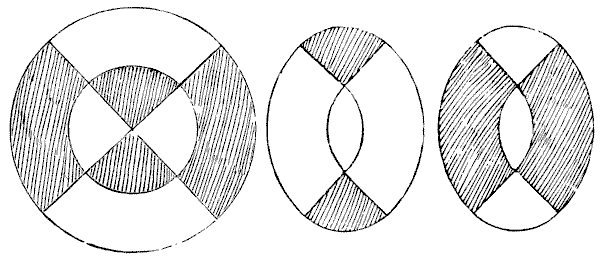I have frequently had occasion to show that the published answers to a great many of the oldest and most widely known puzzles are either quite incorrect or capable of improvement. I propose to consider the old poser of the table-top and stools that most of my readers have probably seen in some form or another in books compiled for the recreation of childhood.
The story is told that an economical and ingenious schoolmaster once wished to convert a circular table-top, for which he had no use, into seats for two oval stools, each with a hand-hole in the center. He instructed the carpenter to make the cuts as in the illustration and then join the eight pieces together in the manner shown. So impressed was he with the ingenuity of his performance that he set the puzzle to his geometry class as a little study in dissection. But the remainder of the story has never been published, because, so it is said, it was a characteristic of the principals of academies that they would never admit that they could err. I get my information from a descendant of the original boy who had most reason to be interested in the matter.
The clever youth suggested modestly to the master that the hand-holes were too big, and that a small boy might perhaps fall through them. He, therefore, proposed another way of making the cuts that would get over this objection. For his impertinence, he received such severe chastisement that he became convinced that the larger the hand-hole in the stools the more comfortable might they be.

Now, what was the method the boy proposed?
Can you show how the circular table-top may be cut into eight pieces that will fit together and form two oval seats for stools (each of exactly the same size and shape) and each having similar hand-holes of smaller dimensions than in the case shown above? Of course, all the wood must be used.
Solutions: 1
This eBook is for the use of anyone anywhere in the United States and most other parts of the world at no cost and with almost no restrictions whatsoever. You may copy it, give it away or re-use it under the terms of the Project Gutenberg License included with this edition or online at http://www.gutenberg.org. If you are not located in the United States, you'll have to check the laws of the country where you are located before using this ebook.